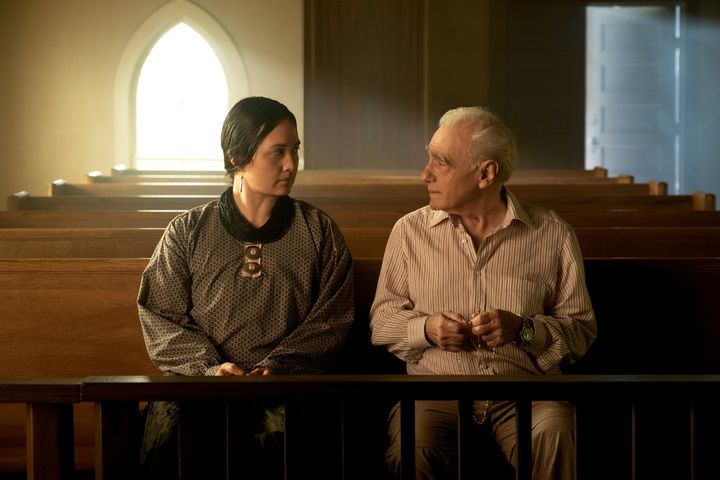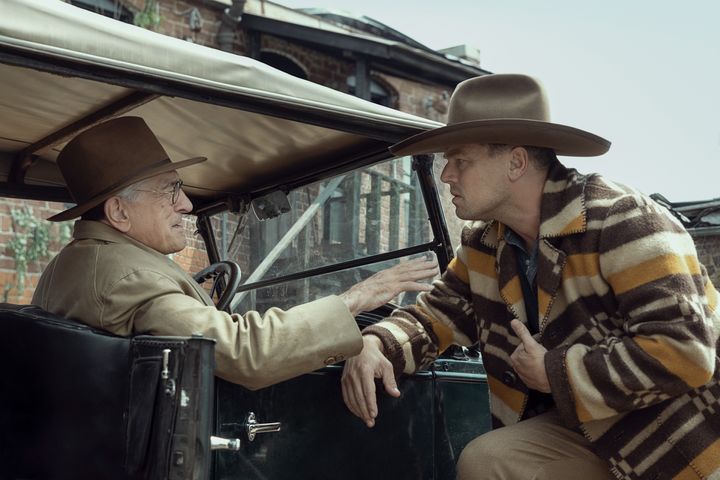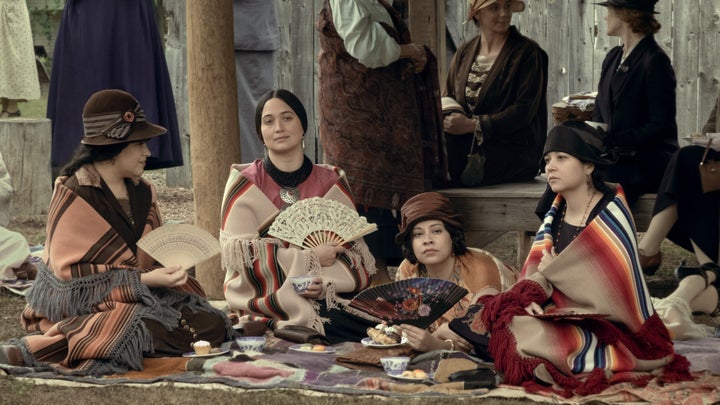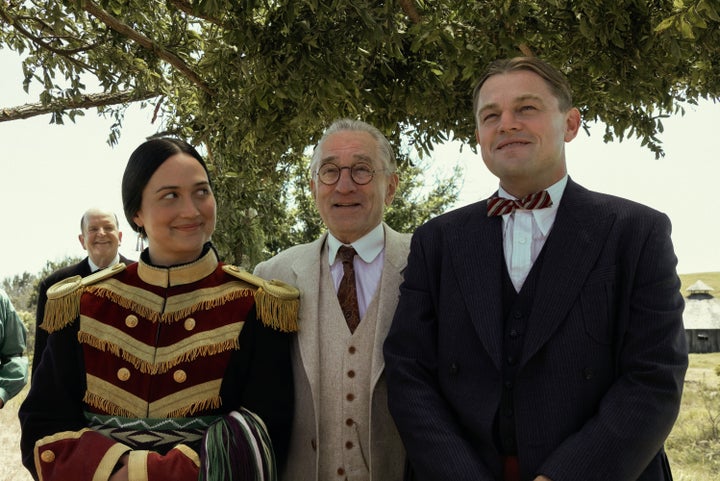
In describing the development of his new film Killers Of The Flower Moon, Martin Scorsese has said the long-gestating project went through a significant rewrite when he made a crucial choice: reframing the story to not make a white man the hero.
Based on New Yorker reporter David Grann’s 2017 book of the same name, the movie was originally about how a federal investigation into a string of murders involving members of the Osage Nation in Oklahoma became a foundation for the FBI. The lead investigator was Tom White, an agent for the Bureau of Investigation, the FBI’s precursor.
Frequent Scorsese collaborator Leonardo DiCaprio initially signed on to play White. But as Scorsese has recounted in recent interviews, such as one with Time magazine: “After a certain point, I realised I was making a movie about all the white guys,” he said. “Meaning I was taking the approach from the outside in, which concerned me.”
The legendary director realised it should really be about the complex marriage of Ernest (now played by DiCaprio) and Mollie Burkhart (Lily Gladstone), and the crimes Ernest committed at the behest of his powerful uncle, Bill Hale (Robert De Niro). As the film depicts, Bill — a Godfather-like figure in town whom everyone calls “King” — orchestrates a yearslong scheme to extort Mollie’s family and other Osage community members in order to seize their wealth and the rights to their oil-rich land. (The character of White, played by Jesse Plemons in the final version, is now much more scaled back and appears only late in the film.)
Scorsese is getting a lot of praise for focusing on the story’s brutality rather than centering a white man as the hero. It’s a better movie for it: an epic and unflinching story of racism, greed, exploitation and plunder.

There’s a bone-chilling brazenness to Bill’s evil. He views everything as a transaction. As part of his long game, he encourages Ernest to marry Mollie, explaining to his nephew in no uncertain terms what marrying her will mean financially. Bill then gradually plots the murders of members of her family, and takes advantage of Mollie and her mother’s ailing health. And the cowardly Ernest is too easily persuaded into becoming his uncle’s accomplice in gradually defrauding his wife’s family, even though he seems to genuinely love her.
The film’s 3-hour-and-26-minute run time is a lot. But it’s hard to imagine a shorter version. You need to see the full scope: the way the film methodically lays out Bill’s sliminess, such as how he positions himself as an ally of and benefactor to the Osage community while plotting to destroy them. Ernest carries out his uncle’s orders even though he knows he’s actively participating in the exploitation of his wife’s family. And throughout the film, many of these crimes happen in plain sight.
By framing the film this way, it also spotlights Gladstone, who has deserved a major role like this ever since her breakout role in Kelly Reichardt’s Certain Women in 2016. Gladstone delivers the film’s most layered performance and serves as its emotional anchor. Through her resolute gaze, we can sense Mollie knows something is up. But what, if anything, can she do to stop it? If it wasn’t Ernest, it would be some other white man trying to exploit her family and community.

But something has kept gnawing at me. While Scorsese warrants praise for the choices he has made here, why must it be exceedingly rare for a white filmmaker — and especially a cinema legend — to do some reflection and realize the story he’s trying to tell shouldn’t solely be about the white men? And to do the work of reframing that story, such as how Scorsese worked extensively with Osage consultants to portray their community’s history with accuracy and dignity? It would be nice if this was just a normal occurrence and not such an unusual one. And in retrospect, framing the story this way should have been more obvious from the outset.
It brought to mind the conversation this summer around Christopher Nolan’s Oppenheimer. That included criticisms that the movie, which depicts the development of the atomic bomb during World War II, doesn’t include the perspectives of the Native communities in New Mexico that were displaced by the Los Alamos facility and harmed by radiation, or the Japanese civilians who experienced the bomb’s devastating impact — and whose descendants continue to grapple with the effects of that history today.
These questions aren’t on Oppenheimer or any one movie to solve. These are historic problems with framing and who gets to tell stories and decide how to tell them. For decades, Hollywood has loved to make World War II movies, and the vast majority of them are about heroic white men. That’s not to say they aren’t good movies, and some of them do complicate the conventional narrative and decline to glorify war. But it’s unusual when they deviate from the form, and there are so many more stories left to tell.
One compelling variation on the World War II genre is Steven Spielberg’s 1987 epic Empire of the Sun, about a British boy (played by Christian Bale and based loosely on author J.G. Ballard) living in Japanese-occupied Shanghai. He becomes separated from his diplomat parents and spends several years as a prisoner of war in a Japanese concentration camp. I think it’s one of Spielberg’s more underrated movies, and in some ways, a more complex one than some of his better-known war films. But still, whenever I rewatch it, I wonder about the Chinese civilians who appear in background shots of the movie. What about their stories of death and destruction? In this story, they are both figuratively and literally relegated to the background of a far more privileged white male protagonist’s story.
There’s the old adage that history is written by the victors. Perhaps a better way of looking at it: History is written by those who have power. It’s certainly a common pattern, whether in classroom textbooks or on screen. It’s especially present in stories about war and conquest, which routinely gloss over acts of evil. Just look at the ways those of us in Western societies have historically been fed stories about colonialism as tales of adventure and discovery — not of genocide and plunder.
At many points, Killers of the Flower Moon plays around with familiar tropes and genres, like true-crime sagas and Westerns. By doing so, Scorsese reminds us of how stories like this are typically framed. It’s easy to imagine those versions of this movie: a suspenseful true-crime caper and a swashbuckling Western. It’s also easy to imagine the original iteration of this movie with a white law enforcement official as the hero, played by a giant movie star. We’ve seen that movie before so, so many times. All of these versions would be doing audiences a disservice, simply entertaining us and sugar-coating the truth.
The film’s ending is both a clever framing device and an absolutely haunting coda, underscoring the ways history all too often erases the kinds of evils Mollie’s family and the Osage people faced — and pretends they never happened. Still, the film could have widened its lens even further. As I watched, I couldn’t stop thinking about the story’s parallels to the current epidemic of missing and murdered Indigenous women. Gladstone herself also stars in Erica Tremblay’s Fancy Dance, a film about a Native woman trying to investigate the disappearance of her sister while taking care of her niece, set in present-day Oklahoma.
And while in Killers of the Flower Moon, the federal government does belatedly intervene and prosecute the crimes by Bill and Ernest, that certainly hasn’t been the norm. If anything, the federal government has been responsible for centuries of Native exploitation — and today continues to neglect and marginalise Native communities. Maybe Scorsese doesn’t need to draw the line between past and present, given the film’s already vast scale and scope. But what’s past is prologue.

There’s also a version of this movie that could have centered Mollie herself, rather than opposite her white husband and his uncle. That’s an important point that one of the film’s Osage language consultants, Christopher Cote, raised when asked about his reaction to the final product.
“As an Osage, I really wanted this to be from the perspective of Mollie and what her family experienced, but I think it would take an Osage to do that,” Cote told the Hollywood Reporter at the film’s Los Angeles premiere last week. “Martin Scorsese, not being Osage, I think he did a great job representing our people, but this history is being told almost from the perspective of Ernest Burkhart, and they kind of give him this conscience and kind of depict that there’s love. But when somebody conspires to murder your entire family, that’s not love. That’s not love, that’s just beyond abuse.”
Once again, this is about who gets to tell stories and decide how to tell them. The cold, hard reality is that it takes the clout of a legendary filmmaker like Scorsese and mega stars like DiCaprio and De Niro to get a movie of this scale made.
Cote went on to point out that it’s also about who the story is for. “I think that’s because this film isn’t made for an Osage audience, it was made for everybody, not Osage,” he said. “For those that have been disenfranchised, they can relate, but for other countries that have their acts and their history of oppression, this is an opportunity for them to ask themselves this question of morality, and that’s how I feel about this film.”
Scorsese’s choice to reframe this story goes a long way toward making us consider these moral questions and sit with that dark history. But it’s going to take plenty more filmmakers at his level interrogating their choices and challenging engrained ways of telling stories in order to rewrite our existing narratives about history into something more honest.
